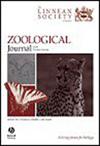A genome-skimming phylogeny of ctenostome bryozoans
IF 2.8
2区 生物学
Q1 ZOOLOGY
引用次数: 0
Abstract
Ctenostome bryozoans pose ongoing challenges for taxonomists and systematists, owing to their lack of character-rich mineralized skeletons. We present the largest (super)family-level phylogeny of Ctenostomatida to date. We resolved the three major clades (A–C) that were recognized previously. Clade A included endolithic taxa Penetrantiidae, Immergentiidae, and Terebripora ramosa, the latter two being sister taxa. Other taxa in this clade were Nolella, Arachnidium, Pottsiella, and Paludicella. Clade B was composed of Alcyonidioidea and Multiporata. The genus Alcyonidium was revealed as non-monophyletic, with the two recovered clades likely to be characterized by contrasting reproductive modes (brooding and zygote spawning). Members of the presumptive brooding clade had insertions of possible exogenous origin in their 18S and 28S ribosomal RNA genes, which might be the result of horizontal gene transfer. Clade C was sister to the Cheilostomatida and was composed of Vesicularioidea, Hislopioidea, Walkerioidea, and three clades of Victorellidae. Anguinella and Hypophorella were consistently sister taxa, but their position was unstable. Results are discussed in light of morphology, reproduction, and previous phylogenetic hypotheses. A revised classification is proposed. Timwoodiellina natans is transferred to Hislopia, Vesicularia spinosa to Amathia, and Monobryozoon ambulans to Alcyonidium. Members of the putative zygote-spawning Alcyonidium clade are transferred to Alcyonidioides in the family Alcyonidioididae.栉齿苔藓虫的基因组扫描系统发育
腱鞘苔藓虫由于缺乏特征丰富的矿化骨骼,对分类学家和系统学家构成了持续的挑战。我们提出了迄今为止最大的(超)家庭水平的栉齿虫系统发育。我们解决了之前识别的三个主要分支(A-C)。进化支A包括内石类群穿孔虫科、潜生虫科和拉莫沙刺虫,后两者为姊妹类群。该支系的其他分类群有Nolella、Arachnidium、Pottsiella和Paludicella。B枝由银卵总目和多孢子目组成。Alcyonidium属是非单系的,这两个分支可能具有不同的生殖模式(孵育和合子产卵)。这些被推测为育龄进化支的成员在其18S和28S核糖体RNA基因上可能有外源的插入,这可能是水平基因转移的结果。C分支是cheilostomatia的姊妹分支,由vesiculario总科、hislopio总科、walkerio总科和Victorellidae的三个分支组成。Anguinella和Hypophorella一直是姐妹类群,但它们的地位不稳定。结果讨论了光形态,繁殖,和以前的系统发育假说。提出了订正分类。Timwoodiellina natans被转移到Hislopia, Vesicularia spinosa被转移到Amathia, Monobryozoon ambulans被转移到Alcyonidium。假定的合子产卵的伞花枝的成员被转移到伞花科的伞花属。
本文章由计算机程序翻译,如有差异,请以英文原文为准。
求助全文
约1分钟内获得全文
求助全文
来源期刊
CiteScore
6.50
自引率
10.70%
发文量
116
审稿时长
6-12 weeks
期刊介绍:
The Zoological Journal of the Linnean Society publishes papers on systematic and evolutionary zoology and comparative, functional and other studies where relevant to these areas. Studies of extinct as well as living animals are included. Reviews are also published; these may be invited by the Editorial Board, but uninvited reviews may also be considered. The Zoological Journal also has a wide circulation amongst zoologists and although narrowly specialized papers are not excluded, potential authors should bear that readership in mind.

 求助内容:
求助内容: 应助结果提醒方式:
应助结果提醒方式:


